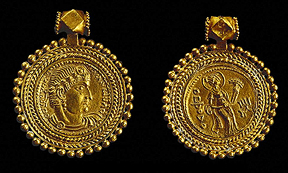
Kushan period, early 4th century CE
Gold
Probably from the Gandhara region (modern north-western Pakistan)
Diameter: 3.5 cm
Weight: 19.98 g
Acquisition number: #CM OR 5200
Image courtesy of the British Museum (copyright reserved).
As experts at the British Museum have noted, though this pendant appears to be made out of a single coin, it is in fact a construction that borrows elements from two separate coins, one Kushan and one Roman.1 On one side is a portrait of the Roman emperor Constantine the Great (reigned 307-37 CE), and includes a crude copy of the inscription giving the name and titles of the emperor in Latin.
On the other side is an image of the Kushan goddess of good fortune, Ardochsho; holding a cornucopia in her arms, her image is based upon that of the Greek goddess Demeter. The inscription identifying this deity is written in the Bactrian language using the Greek script, though here again the inscription is rather blundered. This design is known from the coins minted by the Kushan ruler Kanishka I (reigned approximately 120-46 CE). Such an amalgamation of Mediterranean and Central Asian motifs and languages in a single piece of jewelry creates a perfect visual metaphor for the phenomenon of transferred cultural patterns that we see occurring all along the Silk Road.
(1) See the British Museum web page dedicated to this object.